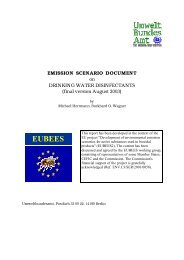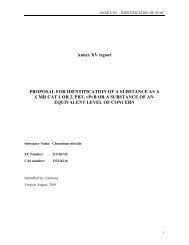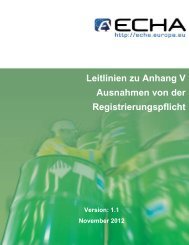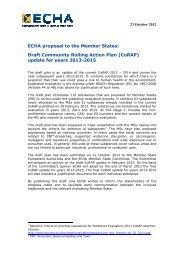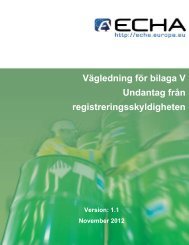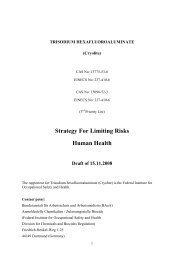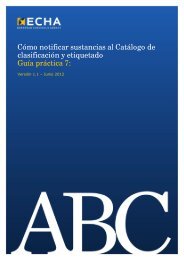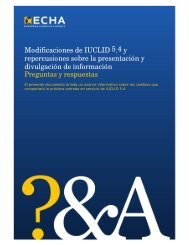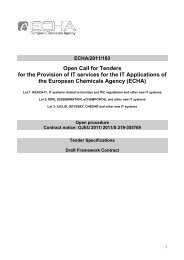Practical Guide 5: How to report (Q)SARs - ECHA - Europa
Practical Guide 5: How to report (Q)SARs - ECHA - Europa
Practical Guide 5: How to report (Q)SARs - ECHA - Europa
You also want an ePaper? Increase the reach of your titles
YUMPU automatically turns print PDFs into web optimized ePapers that Google loves.
3. QUESTIONS ON HOW TO APPLY AND REPORT<br />
(Q)SAR UNDER REACH<br />
3.1. Which Guidance documents should I read?<br />
A four pages summary on how <strong>to</strong> use non-testing data obtained by applying (Q)<strong>SARs</strong> is<br />
available in the Guidance on information requirements and chemical safety assessment<br />
in:<br />
Chapter R.4: Evaluation of available Information:<br />
R.4.3.2.1 (Q)SAR data<br />
A dedicated part on computational methodologies is available in the Guidance on<br />
information requirements and chemical safety assessment in<br />
Chapter R.6: (Q)<strong>SARs</strong> and grouping of chemicals:<br />
R.6.1 Guidance on (Q)<strong>SARs</strong><br />
Relevant <strong>to</strong>ols and approaches for the endpoint(s) of interest are offered by each<br />
endpoint specific guidance document included in the Guidance on information<br />
requirements and chemical safety assessment in:<br />
Chapter R.7: Endpoint specific Guidance.<br />
Information on the use of non-testing degradation and bioaccumulation data for<br />
persistent, bioaccumulative and <strong>to</strong>xic (PBT) chemicals is accessible from the Guidance<br />
on information requirements and chemical safety assessment in:<br />
3.2. Is the (Q)SAR model valid?<br />
Chapter R.11: PBT Assessment.<br />
The validity of (Q)SAR models for regula<strong>to</strong>ry purposes is characterised and documented<br />
according <strong>to</strong> the five agreed OECD principles, as described in the REACH guidance<br />
R.6.1 Guidance on (Q)<strong>SARs</strong>:<br />
1. The (Q)SAR model should be associated with a defined endpoint.<br />
2. The (Q)SAR model should be expressed in form of an unambiguous algorithm.<br />
3. The (Q)SAR model should be associated with a defined domain of applicability.<br />
4. The (Q)SAR model should be associated with appropriate performance of the<br />
model (the statistical “goodness” of the model, robustness and predictivity).<br />
5. The (Q)SAR model should be associated with a mechanistic interpretation for<br />
human health and eco<strong>to</strong>xicological endpoints, if possible.<br />
4






